“How To Pick The Perfect Papaya Every Time”

Introduction to Papaya Trees
Papaya trees (Carica papaya) are tropical plants that have captured attention worldwide. These extraordinary trees are a testament to nature’s incredible diversity and productivity.
Why Papaya Trees Matter
Papaya trees play a role in global agriculture and nutrition, offering:
- A nutrient-dense fruit packed with essential vitamins and minerals
- Fast growth and high fruit yield
- Adaptability to tropical and subtropical climates
- Economic importance for many developing countries
The journey of understanding papaya trees is agriculturally and botanically significant. Their origin is in Central America. These trees have a rich history and potential.
What is a Papaya Tree? Understanding the Basics
Scientific Classification and Origins
The papaya tree belongs to the scientific classification:
- Kingdom: Plantae
- Order: Brassicales
- Family: Caricaceae
- Genus: Carica
- Species: Carica papaya
The trees are native to the regions of southern Mexico and Central America. Papaya trees have been introduced to tropical and subtropical areas around the globe. India, Brazil, Indonesia, and Nigeria are major producers of this remarkable fruit.
Physical Characteristics of Papaya Trees
Papaya trees are distinctive in their appearance and structure:
- Height: Grows 10-20 feet tall
- Trunk: Soft, hollow, and unbranched
- Leaves: Large, palmately lobed, and clustered at the top of the trunk
- Lifespan: Short, 3-5 productive years
Unique Tree Structure
Papaya trees are not true trees but large herbaceous plants. Their soft trunk and rapid growth make them stand out in tropical landscapes. The trunk gives the tree its distinctive appearance and flexibility and is composed of smooth, fibrous material.

Varieties of Papaya Trees
Understanding Papaya Tree Types
Papaya trees exhibit three primary types that impact fruit production:
- Male Papaya Trees
- Produce pollen
- Do not bear fruit
- Essential for pollination of female trees
- Tall and slender
- Female Papaya Trees
- Produce fruit
- Need pollination from male trees
- More robust fruit producers
- More compact growth structure
- Hermaphroditic Papaya Trees
- Contain both male and female reproductive organs
- Self-pollinating
- Common in commercial cultivation
- Produce consistent and reliable fruit yields
Popular Papaya Cultivars
Different papaya varieties have adapted to climates and purposes:
Tropical Varieties:
- Hawaiian Solo: Small, sweet fruits, fitting for commercial production
- Sunrise Solo: Golden-yellow fruits, excellent for fresh consumption
- Kapoho: Large, sweet papayas popular in Hawaiian markets
Caribbean Varieties:
- Red Cuban: Large fruits with deep red flesh
- Mexican Yellow: Bright yellow skin with sweet, soft flesh
Asian Varieties:
- Taiwan Pink: Delicate pink flesh, mild flavor
- Singapore Pink: Larger fruits with a robust taste
Climate Adaptation Factors
- Fruit size
- Flavor profile
- Growth rate
- Disease resistance
- Temperature tolerance
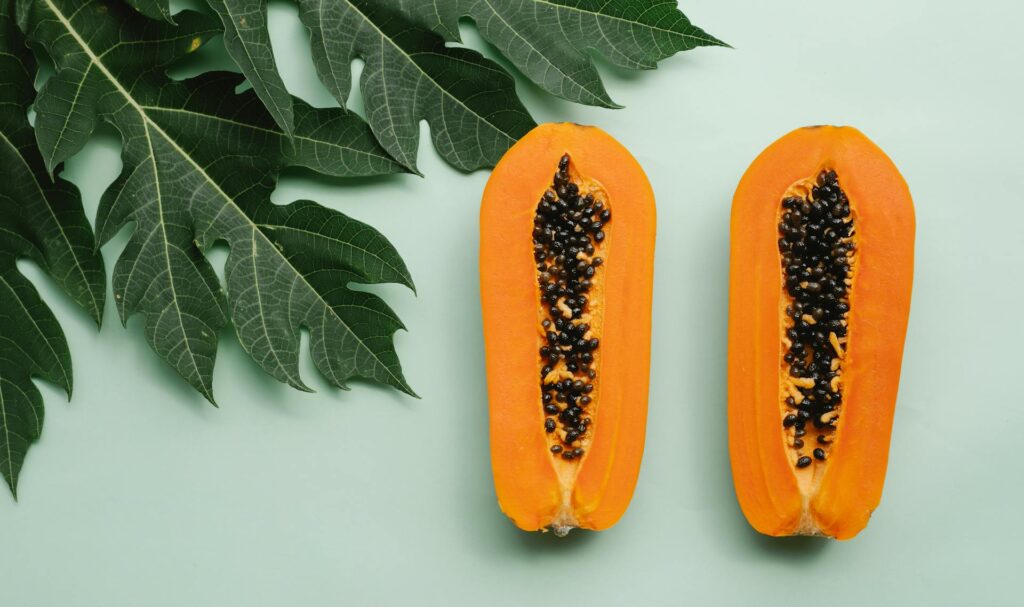
Growing Your Own Papaya Tree: A Comprehensive Guide
Climate and Soil Requirements
Growing papaya trees demands attention to environmental conditions. These tropical plants are sensitive to their growing environment.
Ideal Climate Conditions:
- Temperature Range: 70-85°F (21-29°C)
- Minimum Survival Temperature: 60°F (16°C)
- Frost Sensitivity: Extreme vulnerability to cold
- Optimal Humidity: 60-80% relative humidity
Soil Specifications for Papaya Trees:
- pH Level: 5.5-6.5 (acidic)
- Drainage: Well-draining, loose soil
- Organic Matter: High organic content is preferred
- Preferred Soil Types: Loamy, sandy loam soils
Planting a Papaya Tree: Step-by-Step Process
Seed Selection and Preparation
- Choose seeds from ripe, high-quality papayas
- Select hybrid or improved cultivar seeds
- Remove the seeds from fully ripe fruit
- Clean and dry seeds
Germination Techniques:
- Soak seeds in water for 24 hours
- Use seed-starting trays with light, fertile soil
- Maintain soil temperature around 75-85°F
- Keep soil moist
- Expect germination in 1-2 weeks
Planting Location Considerations
- Sunlight: Full sun exposure (6-8 hours daily)
- Wind Protection: Sheltered areas recommended
- Space Requirements: 8-10 feet between trees
- Avoid Waterlogged Areas: Ensure good drainage
Planting Season Recommendations:
- Tropical Regions: Year-round planting
- Subtropical Areas: Spring or early summer
- Avoid Planting: During extreme temperature periods

Papaya Tree Care and Maintenance
Watering Strategies
- Young Trees: Frequent, light watering
- Mature Trees: Deep, less frequent watering
- Avoid Overwatering: Prevents root rot
- Drought Tolerance: Moderate, but consistent moisture needed
Fertilization Techniques
- NPK Ratio: 5-10-5 or similar balanced fertilizer
- Frequency: Every 2-3 months
- Organic Options: Compost, aged manure
- Micronutrients: Calcium and magnesium essential
Pruning Guidelines:
- Remove dead or yellowing leaves
- Trim lower branches for air circulation
- Cut damaged or diseased sections immediately
Pest and Disease Management
Common Pests:
- Aphids
- Fruit flies
- Spider mites
- Papaya ringspot virus vectors
Prevention Strategies:
- Regular inspection
- Maintain tree health
- Use organic pest control methods
- Practice crop rotation
Pro Tip: Mulching around papaya trees helps moisture, suppress weeds, and regulate soil temperature.
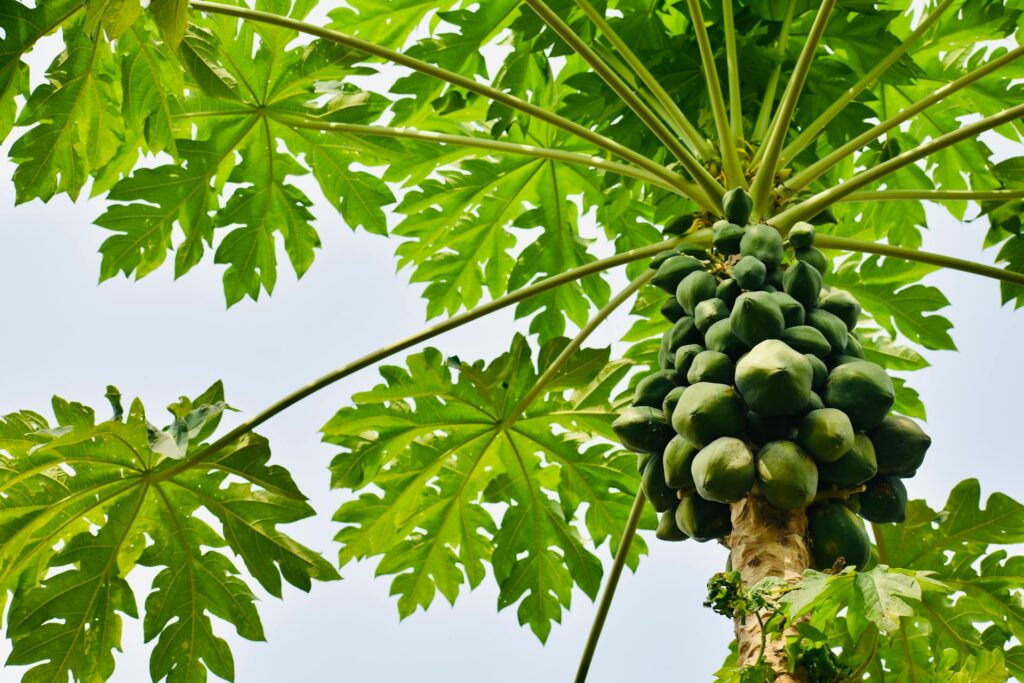
Papaya Tree Lifecycle and Fruit Production
Growth Stages of a Papaya Tree
The lifecycle of a papaya tree is from a tiny seed to a fruit-bearing plant. Understanding these stages is important for cultivation.
Seed to Seedling Stage
- Germination occurs within 1-2 weeks
- Initial growth is rapid
- Seedlings develop first true leaves within 3-4 weeks
- Height reaches 8-12 inches in the first two months
Young Tree Development
- The trunk begins to thicken
- Leaves become larger and more complex
- Root system expands
- Height increases quickly, 1-2 feet per month
- Sexual characteristics become clear
Flowering Process
- First flowers appear 4-6 months after planting
- Flowers are white with five petals
- Male trees produce clusters of small flowers
- Female and hermaphroditic trees produce larger, more robust flowers
- Pollination is critical during this stage
Fruit Formation and Maturation
- Fruit set occurs within 2-3 months after flowering
- Initial fruits are small and green
- Color changes from green to yellow/orange as ripening progresses
- Average fruit development time: 6-9 months from flower to harvest

Fruit Production Insights
Fruit Yield Characteristics
- Average Yield: 30-150 fruits per tree yearly
- Fruit Size: 1-2 pounds per papaya
- Peak Production: Years 2-4 of the tree’s lifecycle
- Continuous Production: In ideal tropical conditions
Factors Affecting Fruit Production
- Climate Conditions
- Temperature stability
- Adequate rainfall
- Humidity levels
- Soil Quality
- Nutrient availability
- pH balanced
- Drainage capabilities
- Pollination
- Presence of male/hermaphroditic trees
- Insect activity
- Wind conditions
- Tree Health
- Pest management
- Proper fertilization
- Regular maintenance
Harvesting Techniques
- Ripeness Indicators:
- Changing skin color from green to yellow/orange
- Slight softening of fruit
- Aromatic smell developing
- Harvesting Methods:
- Use pruning shears
- Cut fruit with a short stem attached
- Harvest when 1/4 to 1/2 of skin has changed color
Harvest Timing
- From Planting to First Harvest: 9-11 months
- Productive Lifecycle: 3-5 years
- Peak Harvest Season: Varies by region and climate
Pro Tip: Planting many papaya trees increases pollination chances. Many trees ensure more consistent fruit production.
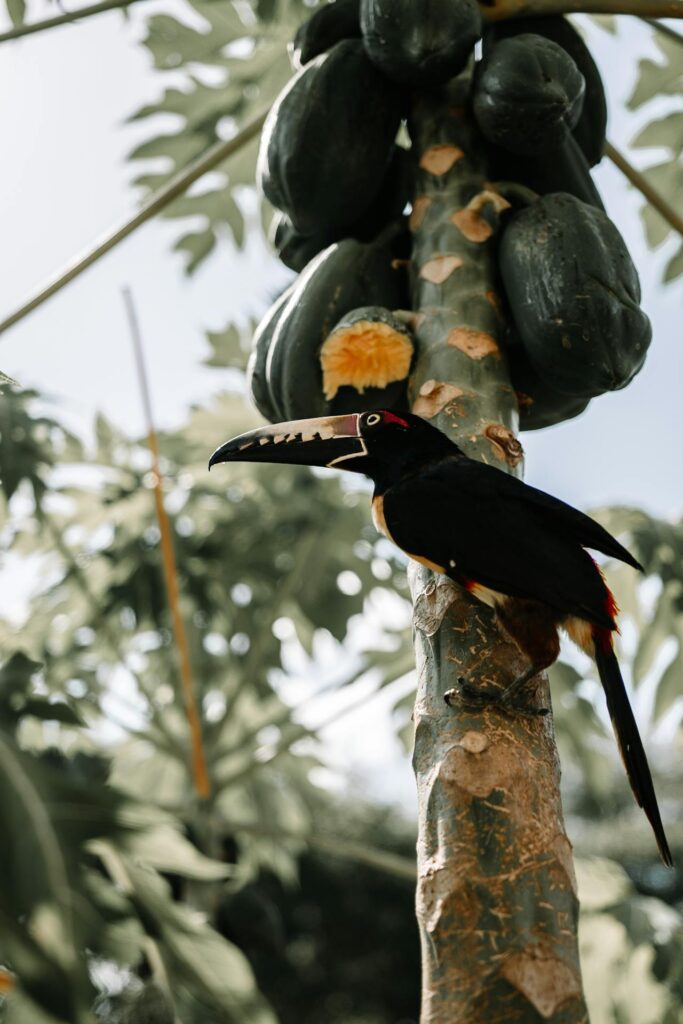
Nutritional Benefits of Papaya Trees
Nutritional Profile of Papayas
Papayas are a powerhouse of nutrition. It offers an impressive array of vitamins, minerals, and health-promoting compounds. The nutritional composition reveals why these fruits are a superfood.
Nutritional Breakdown (per 100g of raw papaya):
- Calories: 43
- Carbohydrates: 10.8g
- Protein: 0.5g
- Fat: 0.3g
- Fiber: 1.7g
Key Vitamins and Minerals:
- Vitamin C: 168% of the daily recommended value
- Powerful antioxidant
- Supports immune system
- Promotes skin health
- Vitamin A: 22% of the daily recommended value
- Essential for eye health
- Supports immune function
- Promotes cell growth
- Folate: 10% of daily recommended value
- Crucial for cell division
- Supports pregnancy health
- Helps prevent anemia
- Potassium: 8% of daily recommended value
- Regulates blood pressure
- Supports heart health
- Maintains electrolyte balance
Antioxidant Properties Papayas are rich in antioxidants:
- Lycopene: Reduces cancer and heart disease risk
- Beta-carotene: Supports eye and skin health
- Flavonoids: Anti-inflammatory compounds
- Choline: Supports brain function
Health Benefits
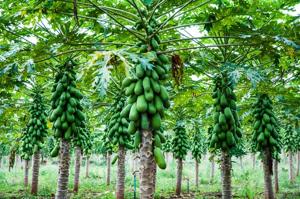
Digestive Health
- It contains papain, a digestive enzyme
- Helps break down proteins
- Alleviates digestive issues
- Reduces bloating and constipation
Immune System Support
- High vitamin C content
- Boosts white blood cell production
- Enhances the body’s defense mechanisms
- Helps fight infections
Anti-Inflammatory Effects
- Reduces chronic inflammation
- May help prevent various diseases
- Supports joint and heart health
- Reduces arthritis symptoms
Heart Health
- Lowers cholesterol levels
- Reduces risk of heart disease
- Improves blood circulation
- Supports cardiovascular function
Medicinal Uses in Traditional Medicine
Historical Applications:
- Wound healing
- Digestive treatments
- Menstrual pain relief
- Skin condition management
Modern Research Insights
- Potential anti-cancer properties
- Blood sugar regulation
- Skin regeneration
- Wound healing acceleration
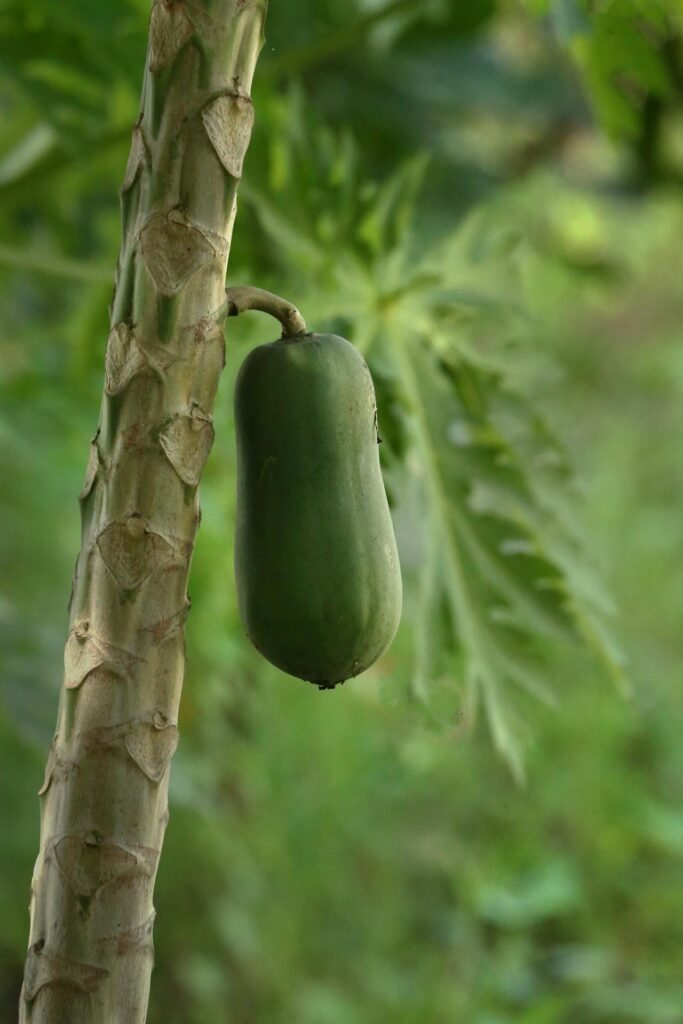
Beyond the Fruit: Other Uses of Papaya Trees
Leaf Applications
- Natural wound dressing
- Treatment of skin infections
- Potential antimicrobial properties
Latex Uses
- Meat tenderizer
- Pharmaceutical preparations
- Natural enzyme extraction
Ecological Benefits
- Soil fertility improvement
- Carbon sequestration
- Habitat for beneficial insects
- Sustainable agricultural practice
Sustainable Agriculture Practices
- Low water requirements
- Rapid growth cycle
- Minimal pesticide needs
- Intercropping potential
Interesting Fact: Papaya leaves are used to treat malaria and dengue fever.
Papaya Tree Challenges and Solutions
Common Pests and Diseases
Papaya trees face challenges that can impact their health and fruit production. Understanding these threats is important for successful cultivation.
Major Pest Threats:
- Papaya Ringspot Virus (PRSV)
- Most devastating viral disease
- Transmitted by aphids
- Causes yellowing and mosaic patterns on leaves
- Stunts tree growth
- Prevention:
- Use virus-resistant cultivars
- Remove infected plants immediately
- Control aphid populations
- Fruit Flies
- Lay eggs in developing fruits
- Larvae destroy fruit from inside
- Significant economic damage
- Management Strategies:
- Sticky traps
- Biological control methods
- Proper fruit disposal
- Timely harvesting
- Mealybugs
- Suck plant sap
- Transmit viral diseases
- Cause leaf distortion
- Control Methods:
- Natural predators
- Neem oil treatments
- Regular inspection
- Pruning infected areas
Fungal Diseases:
- Phytophthora Root Rot
- Powdery Mildew
- Anthracnose
Disease Prevention Techniques:
- Maintain proper drainage
- Ensure good air circulation
- Use fungicide treatments
- Practice crop rotation
- Keep the garden area clean

Environmental Stress Factors
Impact of Climate Change
- Drought Resistance
- Increasing water scarcity challenges
- Developing drought-tolerant varieties
- Adaptation Strategies:
- Mulching
- Efficient irrigation
- Selecting resilient cultivars
- Temperature Extremes
- Sensitive to cold and heat
- Optimal temperature range: 70-85°F
- Mitigation Techniques:
- Shade cloth in extreme heat
- Protective coverings during cold spells
- Microclimate management
- Soil Degradation
- Nutrient depletion
- Erosion risks
- Sustainable Practices:
- Cover cropping
- Organic matter addition
- Minimal tillage
Adaptation Techniques
- Select region-specific varieties
- Install protective barriers
- Develop resilient agricultural practices
- Use advanced cultivation technologies
Frequently Asked Questions
1. How long does it take for a papaya tree to bear fruit?
- 9-11 months from planting
- Depends on variety and growing conditions
2. Can papaya trees grow in containers?
- Yes, with proper care
- Choose dwarf varieties
- Ensure adequate drainage
- Provide enough sunlight
3. What are the most common papaya tree diseases?
- Papaya Ringspot Virus
- Phytophthora Root Rot
- Powdery Mildew
- Anthracnose
4. How many papayas can one tree produce?
- 30-150 fruits yearly
- Depends on tree health and growing conditions
5. Are papaya trees difficult to maintain?
- Moderate difficulty
- Need consistent care
- Sensitive to environmental changes
- Reward with abundant fruit production

Conclusion
Papaya trees represent an intersection of agricultural, nutritional, and ecological value. These trees offer tremendous benefits for gardeners, farmers, and nutrition enthusiasts.
Key Takeaways:
- Versatile tropical plants
- Rich in nutrients
- Easy to cultivate
- Significant agricultural and medicinal value
By understanding their lifecycle and nutritional profile anyone can grow and enjoy these trees. Papaya trees offer a fascinating and rewarding cultivation experience.